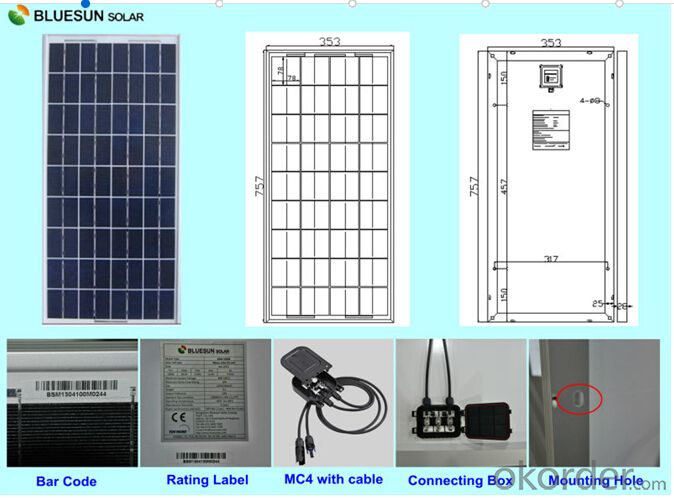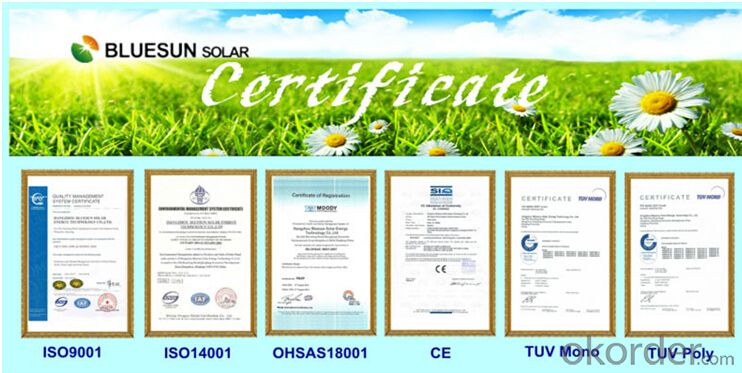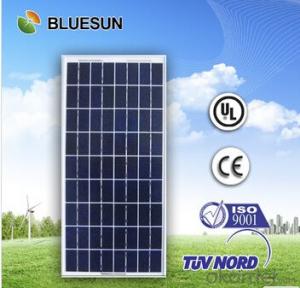Polycrystalline Silicon Solar Modules 30Watt
- Loading Port:
- Shanghai
- Payment Terms:
- TT or LC
- Min Order Qty:
- 300 watt
- Supply Capability:
- 3000000 watt/month
OKorder Service Pledge
OKorder Financial Service
You Might Also Like
Poly-Crystalline solar panel, Poly 156 cell, 36pcs. cut cell 30W
1. Main Features of the Polycrystalline Silicon Solar Modules 30Watt Description
Quality and Safety
1. Rigorous quality control meets the highest international standards.
2. High-transmissivity low-iron tempered glass, strong aluminium frame.
3. Using UV-resistant silicon.
4. IS09001/14001/CE/TUV/UL
Warranties
1. 10 years limited product warranty
2. 15 years at 90% of the minimal rated power output
3. 25 years at 80% of the minimal rated power output
2. Polycrystalline Silicon Solar Modules 30Watt Specification
| Bluesun,poly 156cells, 30w panel | |||||
| Maximum Power(W) | 30wp | ||||
| Optimum Power Voltage(Vmp) | 17.3v | ||||
| Optimum Operatige Current(Imp) | 1.73A | ||||
| Open Circuit Voltage(Voc) | 21.8V | ||||
| Short Circuit Current(Isc) | 2.08A | ||||
| Solar Cell: | 156*156mm Poly | ||||
| Number of Cell(pcs) | 4*9 | ||||
| Brand Name of Solar Cells | JA Cell, Bluesun Cell | ||||
| Size of Module(mm) | 757mm*353mm*25mm | ||||
| Caple & Connector Type | Pass the TUV Certificate | ||||
| Frame(Material Corners,etc.) | Aluminium-alloy | ||||
| Backing (Brand Type) | TPT | ||||
| Cell Efficiency(%) | 17.73 | ||||
| Weight Per Piece(KG) | 3.1KG | ||||
| FF (%) | 70-76% | ||||
| Junction Box Type | Pass the TUV Certificate | ||||
| Tolerance Wattage(e.g.+/-5%) | ±3% | ||||
| Front Glass Thikness(mm) | 3.2 | ||||
| Temperature Coefficients of Isc(%) | 0.035%/K | ||||
| Temperature Coefficients of Voc(%) | 0.351%/K | ||||
| Temperature Coefficients of Pm(%) | 0.47%/K | ||||
| Temperature Coefficients of Im(%) | 0.04 | ||||
| Temperature Coefficients of Vm(%) | -0.38 | ||||
| Temperature Range | -40°C to +85°C | ||||
| Surface Maximum Load Capacity | 2400Pa | ||||
| Allowable Hail Load | 23m/s ,7.53g | ||||
| Bypass Diode Rating(A) | 10 | ||||
| Warranty | 90% of 10 years,80% of 25 years. | ||||
| Standard Test Conditions | AM1.5 1000W/ 25 +/-2°C | ||||
| Packing | carton or pallet | ||||
3. Detail picture of Polycrystalline Silicon Solar Modules 30Watt

4. Packaging & Shipping of Polycrystalline Silicon Solar Modules 30Watt

Packaging
* Normally packing: 1pc/2pcs/3pcs/10pcs/25pcs per carton
* Individual packing requirement is acceptable.
Shipping
By Sea | Delivery from Shanghai or Ningbo seaport |
By Air | Departure from Shanghai Pudong Airport |
By Express | Post by DHL, EMS, UPS, TNT. |
5. Certificate of Polycrystalline Silicon Solar Modules 30Watt

- Q:how much energy does a kilowatt solar panel produce in a year? (average)
- Also you can look for INSOLATION TABLES on the Internet. Keep in mind, though, that the useful output of a solar system that produces AC will be somewhat less than the theoretical value. Local conditions, orientation of the modules, dust on modules, wire resistance losses and efficiency of inverters will drag down the true output. My 6 kW system produces just over 4 kW at optimum sun height.
- Q:am having a 75 watts siemens solar panel and is giving me 2.89volts during bright light, i wanted to know can this be used to charge 00Am/hr battery?
- Many of the panels used on homes are designed to produce 2 volts DC. 0 of them wired in a series would produce 20 volts DC. An inverter is used to change the DC voltage to AC. The other aspect of electricity is amperage. With electrical units wired in series the voltage is added. When they are wired in parallel the amperage is added. The Volts x Amps produced will give you the wattage. A wise homeowner will examine their electric bills or the equipment used to determine their demand. They will consult tables that let them know how much sunlight their area receives each year as this will alter the rated performance of the panels. Then they will try and determine how much of the demand they want to fill. 80% may be economical. Then they also want to determine what they will do with excess electricity that may be produced during the summer months of intense sun and how they will supply the shortfall of low sun winter months. From all this they will determine the number of solar panels they need to purchase.
- Q:Can solar panels be installed on a hospital or healthcare facility?
- Yes, solar panels can be installed on a hospital or healthcare facility. Installing solar panels on such facilities can help reduce carbon emissions and energy costs, while also providing a reliable and sustainable source of electricity. Additionally, the use of solar energy aligns with the healthcare industry's commitment to promoting environmental sustainability and reducing the overall carbon footprint.
- Q:Can solar panels be used for outdoor lighting?
- Yes, solar panels can be used for outdoor lighting. In fact, they are an efficient and eco-friendly option for providing illumination in outdoor spaces. Solar panels convert sunlight into electricity, which can be stored in batteries and used to power outdoor lights during the night. This eliminates the need for connecting to the electrical grid and reduces energy costs. Additionally, solar-powered outdoor lighting systems are easy to install and maintain, making them a popular choice for various outdoor applications.
- Q:Are there any government incentives for installing solar panels?
- Yes, there are various government incentives available for installing solar panels. These incentives can include tax credits, grants, and rebates. They aim to promote the use of renewable energy sources and reduce reliance on traditional fossil fuels.
- Q:What, if any, improvement in efficiency per square foot or meter is realized by a solar panel in space vs. being mounted on the ground where the light is attenuated by the atmosphere?In passing, I found a site that gives an output of .89 watts / 4 in. sq for a particular home-mounted panel.
- Solar panels on spacecraft are a lot more efficient than ones made for home use. That doesn't include the effect of the atmosphere.
- Q:What is the main material for making solar panels?
- You can also according to their own needs, according to the power to buy a good package of solar photovoltaic products.
- Q:How much energy can solar panels generate?
- The amount of energy solar panels can generate depends on various factors such as the size and efficiency of the panels, the location and orientation of the installation, and the amount of sunlight available. On average, a typical solar panel can generate about 250 to 400 watts per hour. However, larger solar installations or those with higher efficiency panels can generate several kilowatts or even megawatts of energy, which is enough to power homes, businesses, or even entire cities.
- Q:i'm making a small solar panel powered fan but it cant run the cellphone vibration motor even i have place two x2 solar panel.
- Did okorder / . Possibly this could immediately instruct each and every one!
- Q:I'm making a model of a solar photovoltaic tower for a school project. I need a way to store energy, and we thought about using capacitors (mainly because of our somewhat limited funding). The tower will have a small photovoltaic panel (around the size of a laptop keyboard with number pad) and some (around 50) quot;heliostats(just the mirrors, no moving parts). What kind of capacitors should i use? and would a capacitor bank be better? i am getting confused with all those uF, pF and can't see the difference.Thanx in advance
- You need a rechargeable battery.Those uF you are talking about are Micro farads and pf are a million times smaller,they are less than gnat-bites compared to any rechargeable battery.You can get metal/metal hydride storage batteries (about .4v)and connect them in series if the voltage you generate is greater than that or in parallel if voltage is lower.Hard to advise without knowing voltage output from your design.As to getting hold of them there are so many in use you are sure to find someone who will lend a few (I would anyway!).
1. Manufacturer Overview |
|
|---|---|
| Location | |
| Year Established | |
| Annual Output Value | |
| Main Markets | |
| Company Certifications | |
2. Manufacturer Certificates |
|
|---|---|
| a) Certification Name | |
| Range | |
| Reference | |
| Validity Period | |
3. Manufacturer Capability |
|
|---|---|
| a)Trade Capacity | |
| Nearest Port | |
| Export Percentage | |
| No.of Employees in Trade Department | |
| Language Spoken: | |
| b)Factory Information | |
| Factory Size: | |
| No. of Production Lines | |
| Contract Manufacturing | |
| Product Price Range | |
Send your message to us
Polycrystalline Silicon Solar Modules 30Watt
- Loading Port:
- Shanghai
- Payment Terms:
- TT or LC
- Min Order Qty:
- 300 watt
- Supply Capability:
- 3000000 watt/month
OKorder Service Pledge
OKorder Financial Service
Similar products
New products
Hot products
Related keywords





























